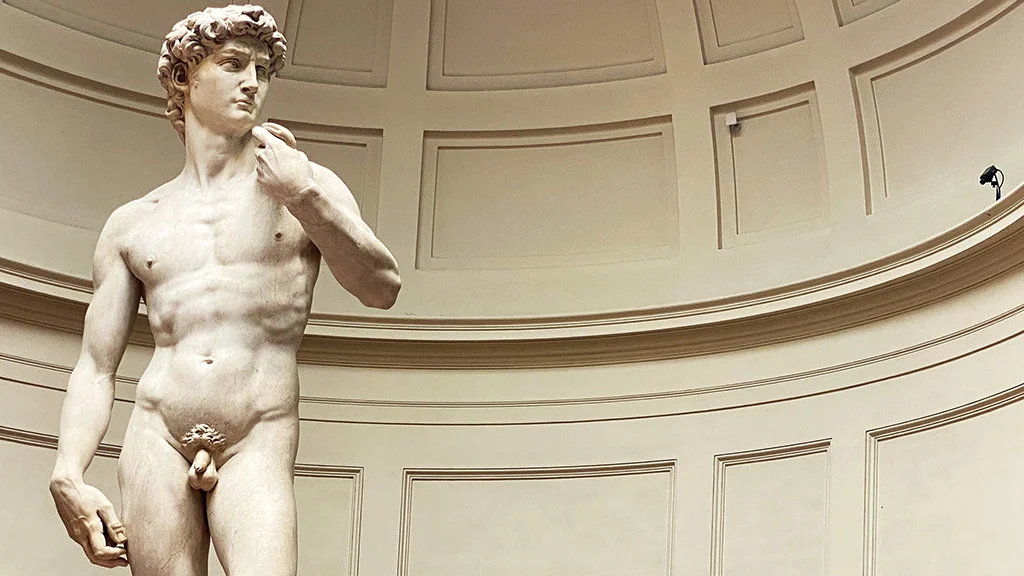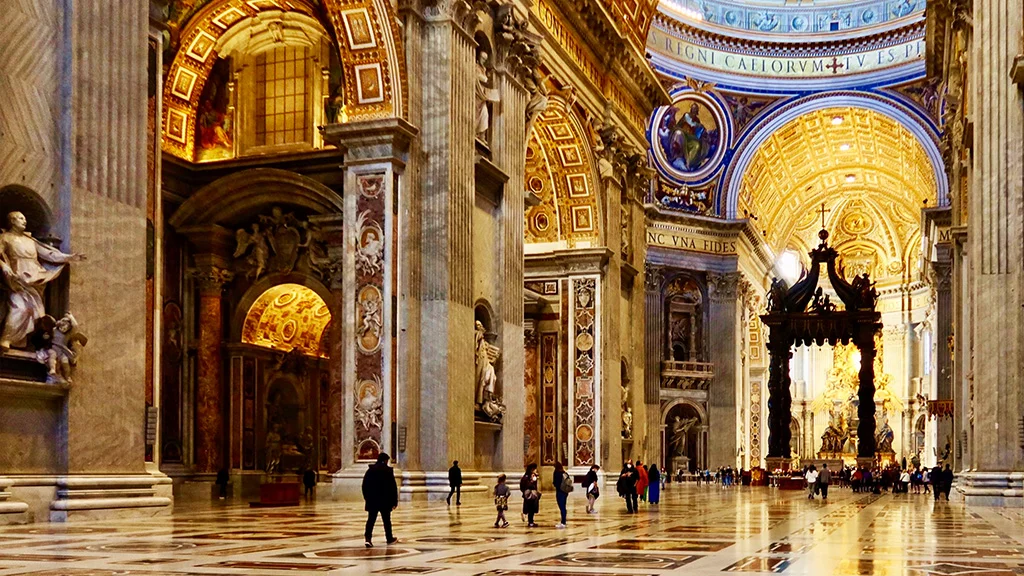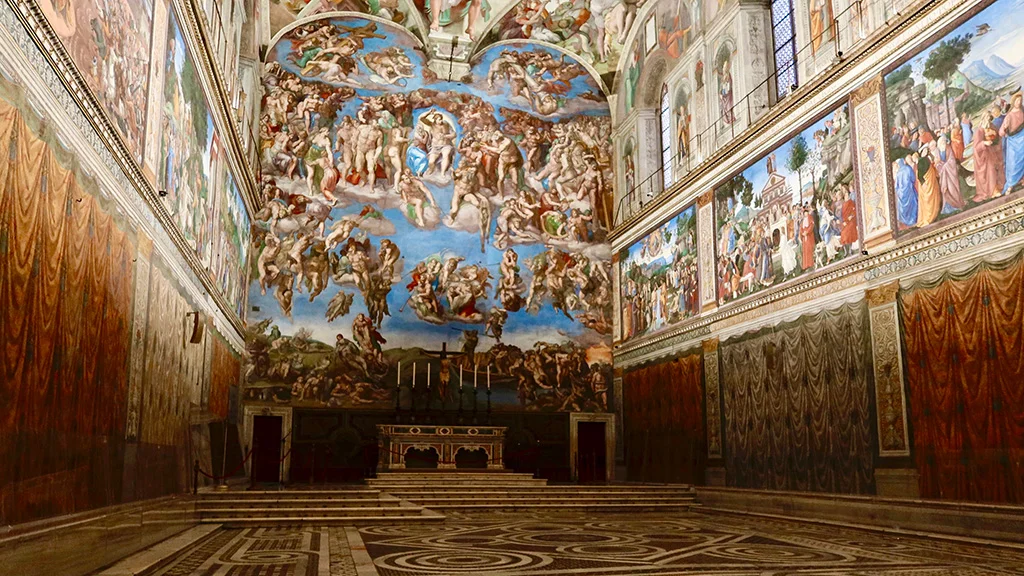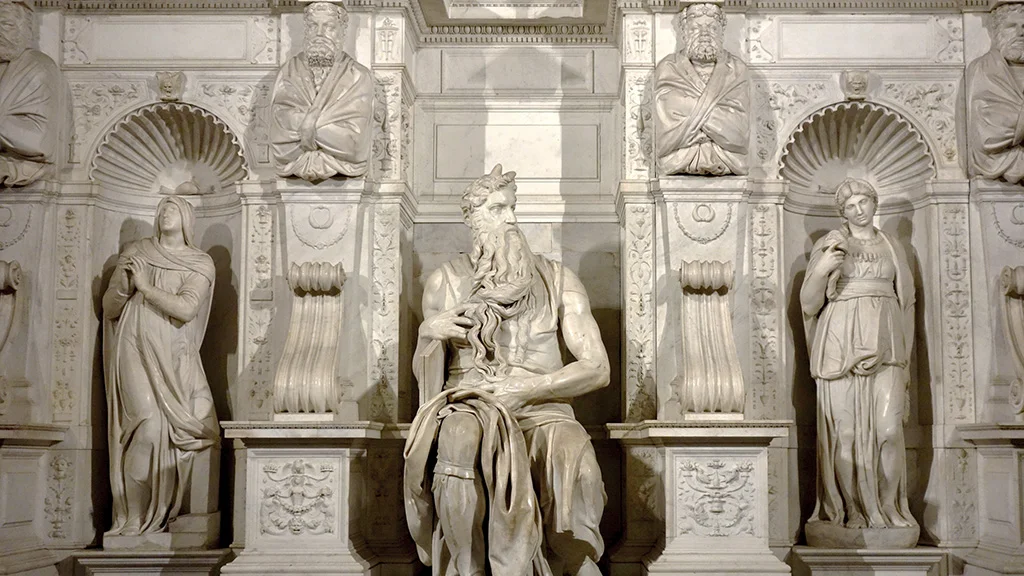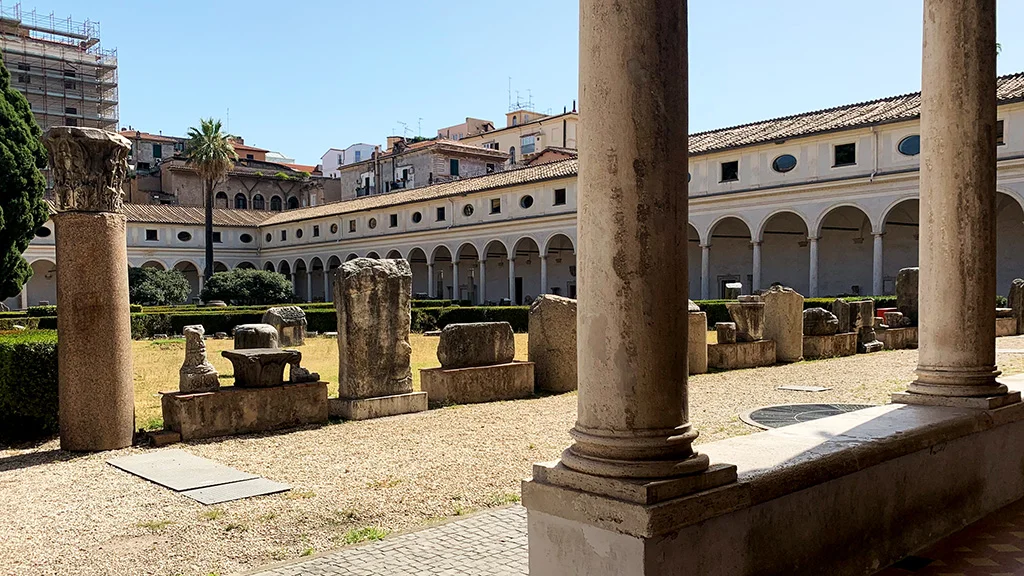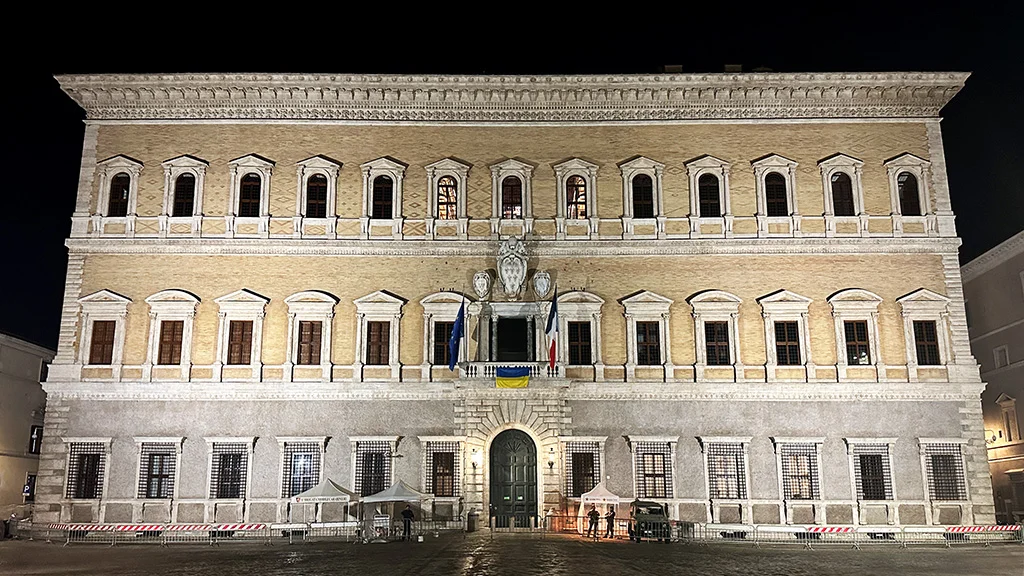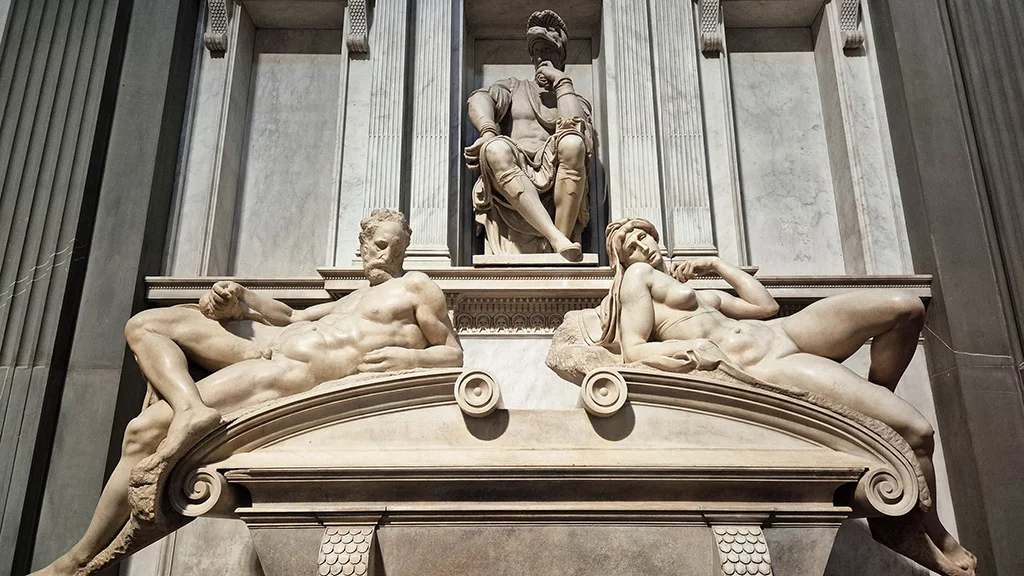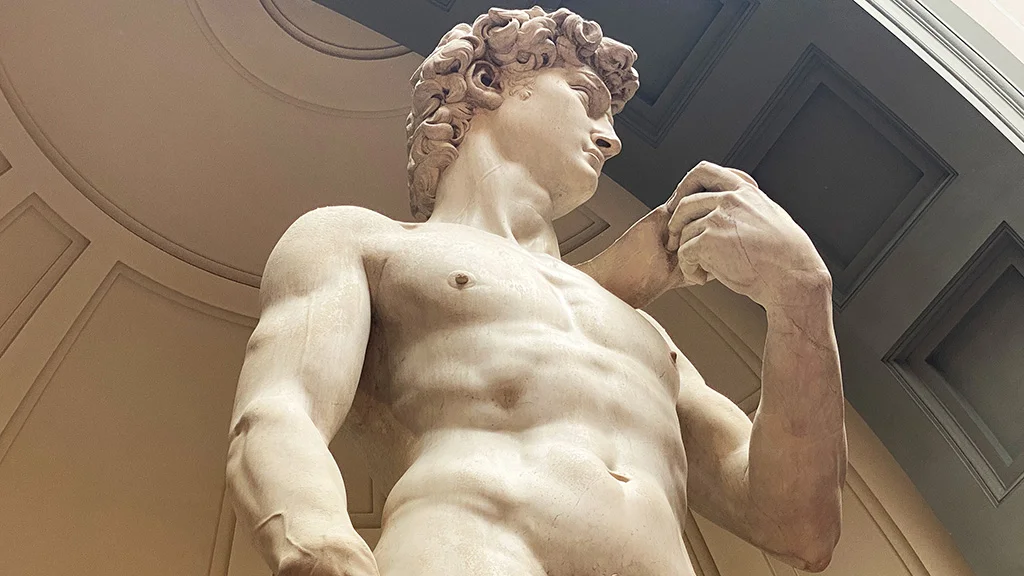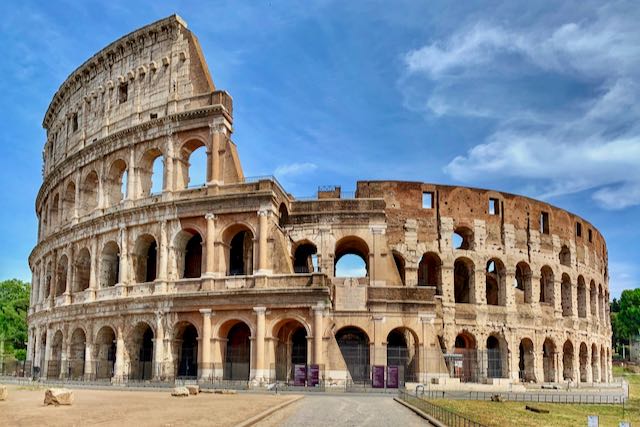- Sign up & get a FREE ebook Subscribe NOW!
- Romewise Home Page
- What to Do in Rome
- michelangelo in rome
Michelangelo in Rome: Where To Find The Renaissance Master Beyond The Vatican
Since Michelangelo is my favorite artist of all time, I think I'm pretty lucky to live in Rome where I can see so many works by him.
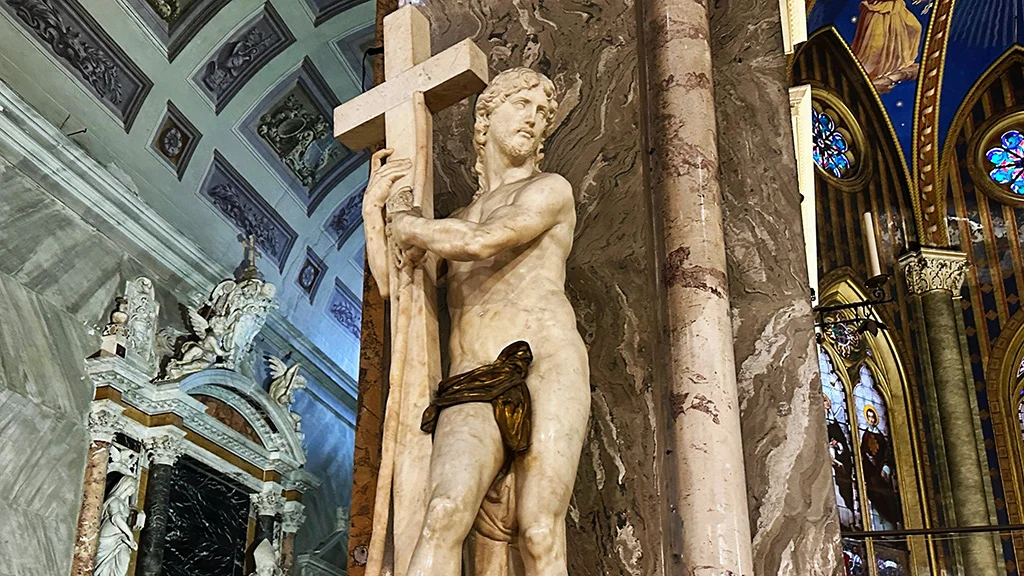 Many visitors miss this church, which means they miss seeing this sculpture of Christ the Redeemer by Michelangelo.
Many visitors miss this church, which means they miss seeing this sculpture of Christ the Redeemer by Michelangelo.And while I know many of you come to Rome to see Michelangelo's masterpieces at the Vatican like his Pietà and his Sistine Chapel ceiling, you may be interested to know where else you can find his work throughout the city.
But guess what?
I am not only going to share all his well-known works in Rome.
I have a few surprising places in Rome where you can find Michelangelo that most people don't know about.
Discovering Michelangelo in Rome - Everything You Need to Know
Michelangelo was born near Florence and began his working life there.
His work in that city is second to none, but I think many people don't realize that Michelangelo spent most of his life in Rome.
His talent shone through before he was even 20 years old.
At around that time, he began what would become a lifetime of working for patrons in Rome, from wealthy individuals to, of course, the pope.
And it was not just "the pope."
Michelangelo would eventually work for 9 popes.
So, besides all his work in Vatican City, where else can you find Michelangelo in Rome?
While his work on the Sistine Chapel ceiling is world-famous, Michelangelo's masterpieces can be found all over the city in museums, churches, and piazzas.
And, as I mentioned, I know of some special secret spots that almost nobody knows are associated with Michelangelo.
If you love Michelangelo the way I do, if you want to get in on these secrets so you can feel his presence in Rome, keep reading.
On this page I'll cover:
- Michelangelo at the Vatican
- Sculptures by Michelangelo in Rome (there are two I bet you don't know)
- Michelangelo's architectural work
- Michelangelo's influence on other artists (like Raphael)
- Where to find traces of Michelangelo in Rome - where he lived and died in Rome
- Other places in Italy to see Michelangelo's work
Click here to open a map of all the places listed on this page (it opens in a new window).
Michelangelo at the Vatican
Michelangelo created vast amounts of artwork for the Vatican.
His most famous contributions are the designs for St Peter's Basilica and the frescoes on the Sistine Chapel ceiling in the Vatican Museums.
St Peter's Basilica
The first version of Saint Peter's Basilica, also known as the Constantinian basilica, had been built without proper foundation.
By the end of the 15th century, it was unstable and leaning heavily to one side.
Pope Nicholas V, (1447–55) decided it was time to rebuild the basilica, although his project never got off the ground.
Pope Julius II, the same pope who harangued Michelangelo into painting the ceiling of the Sistine Chapel, realized in the early 1500's that Saint Peter's Basilica needed to be rebuilt.
This was in part because he'd tapped Michelangelo to build a tomb for him that would have been too large and too heavy to be placed inside the current building.
Many artists and architects were tasked with coming up with the design for what would be the new basilica, but the job of chief architect would eventually fall to Michelangelo in 1546, when Pope Paul III had him take over.
Michelangelo worked on St Peter's Basilica until his death.
He designed the beautiful cupola (dome), but never got to see it completed.
He modeled the basilica's dome partly on the Rome Pantheon, and partly on the dome of Florence cathedral (both church's domes consist of two shells).
Not only did he redesign St Peter's Basilica to its original Greek cross floor plan, but one of his most stunning marble sculptures is inside.
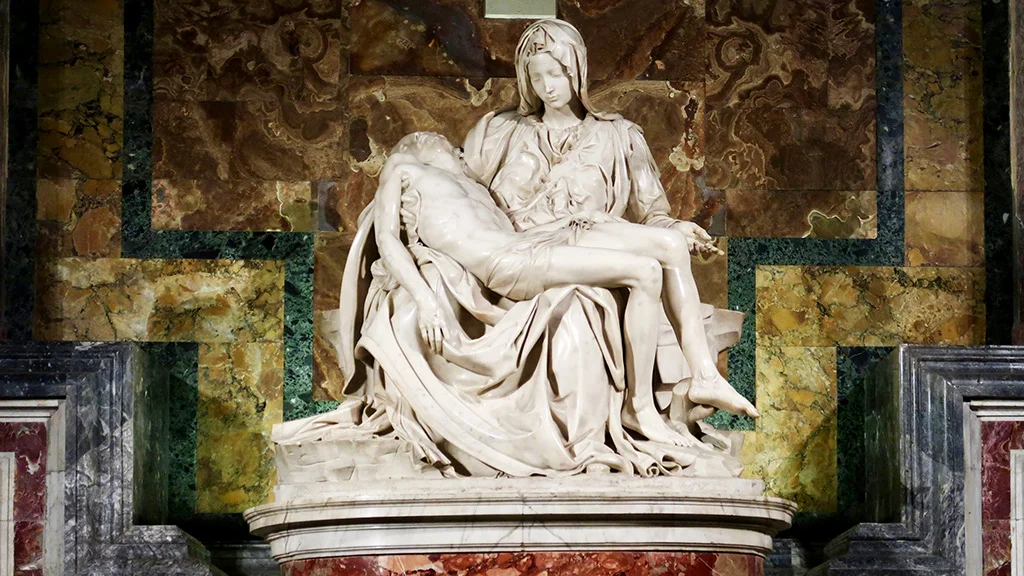 Even though the pietà is one of Michelangelo's earliest works, I always consider it one of his greatest achievements.
Even though the pietà is one of Michelangelo's earliest works, I always consider it one of his greatest achievements.The Pietà depicts the Virgin Mary holding her crucified son moments after his death.
It's one of the key pieces of Renaissance art and the only piece of Michelangelo's art he ever signed (or needed to sign).
Vatican Museums
Two of Michelangelo's most famous works are in the Sistine Chapel, located in the Vatican Museums.
He frescoed the Sistine Chapel ceiling between 1508 and 1512.
Pope Julius II commissioned Michelangelo for the job, despite fierce objections by the artist that he was a sculptor, not a painter.
But, as we all know, Michelangelo lost that argument.
He painted nine scenes from the Book of Genesis on the ceiling of the Sistine Chapel.
Probably the most famous scene, the Creation of Adam, is in the center.
Later, between 1536 to 1541, Michelangelo painted The Last Judgement fresco on the altar wall of the Sistine Chapel.
At the request of Pope Paul III, he also painted two large frescoes for the Pauline Chapel (also known as the Chapel of Saint Peter and Saint Paul).
This chapel is not open to the public.
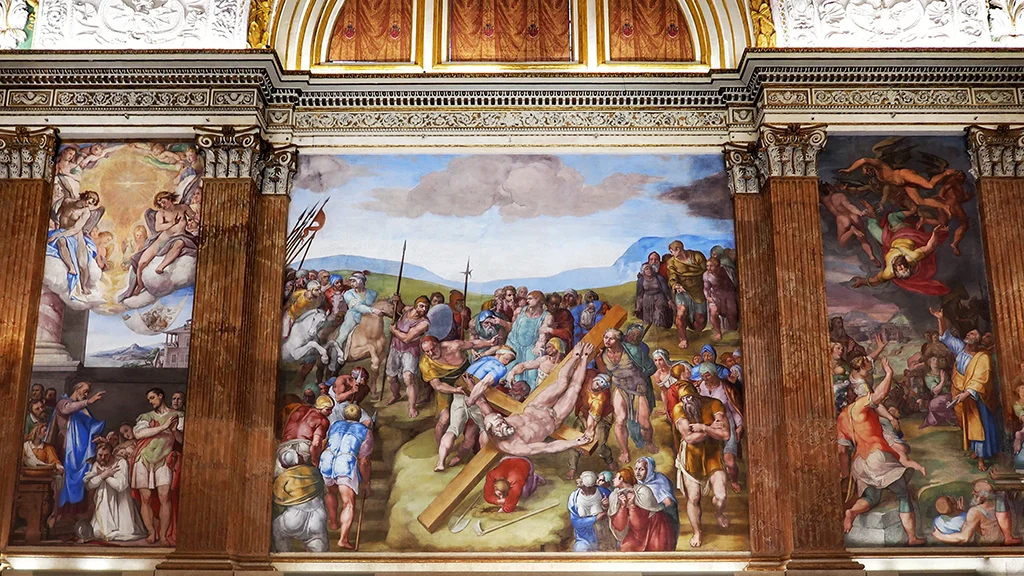 Michelangelo painted these scenes towards the end of his life, and while they are not as brilliant as the frescoes inside the Sistine Chapel, I think they are wonderful just the same.
Michelangelo painted these scenes towards the end of his life, and while they are not as brilliant as the frescoes inside the Sistine Chapel, I think they are wonderful just the same.Want to learn more about Michelangelo at the Vatican?
Sculptures by Michelangelo in Rome
Michelangelo's Pietà may be his most famous sculpture in Rome, but there are a few more to see elsewhere in the city, and they are well worth going out of your way for.
Make sure to read all the way to the end of this section to learn about two Michelangelo sculptures in Rome that most people don't know about.
Moses and the Tomb of Pope Julius II - Church of San Pietro in Vincoli
This is one of those great 'what-if' stories that I love thinking about.
Pope Julius II commissioned Michelangelo to create his funeral monument in 1505.
It began as one of Michelangelo's earliest works in Rome, but it wasn't completed until 1545 (32 years after the pope's death) and Michelangelo, ever the perfectionist, was never completely satisfied with it.
Originally designed to be a massive structure with 40 different statues, the final monument was much smaller than intended.
It had run way over budget and time, so the current pope, Clement VII, decided to put the monument in the church of Saint Peter in Chains, San Pietro in Vincoli, in order to get the project finished.
The small church, while important, was nowhere near as prestigious a location as St Peter's Basilica.
Had the full design been completed, it would undoubtedly have been one of the most famous works by Michelangelo.
I love the figure of Moses in the center, partly because the legend goes that it's one of Michelangelo's favorite pieces of art that he ever made.
He supposedly considered his sculpture of the prophet so life like that he commanded the statue to speak.
Supposedly you can see the mark where the artist banged his hammer on Moses' knee in frustration when he didn't.
The Risen Christ - Church of Santa Maria Sopra Minerva
Commissioned to sculpt a naked Christ for the church of Santa Maria Sopra Minerva in 1514, Michelangelo abandoned his first attempt after discovering a flaw in the marble that left an ugly dark streak across Jesus's face.
Michelangelo left Rome for Florence not long afterwards, but returned to the project in 1518.
The sculpture was placed in the basilica in 1521 and has stayed there ever since.
Often artwork would be moved around in Rome, so I love that this piece shaped by Michelangelo that I visit regularly was seen by the artist in the same place.
The depiction of Christ was originally completely naked, and the gilt loincloth was added later during a period where the Catholic Church was revising their approach to depictions of nudity.
So don't judge Michelangelo for the awkward placement of the loincloth.
The Basilica of Santa Maria Sopra Minerva is near the Pantheon so it is easy to visit.
I often find that this church has very few visitors despite its proximity to the Pantheon, so you can really take your time and admire the sculpture in all its glory.
An Obscure Tomb of a Young Friend - Basilica di Santa Maria in Ara Coeli
The first lesser-known sculpture from Michelangelo is in one of my favorite churches in Rome.
Inside the Basilica of Santa Maria in Ara Coeli is a small, often-missed tomb designed by Michelangelo that I am very fond of.
It belongs to Cecchino Bracci, a 15-year-old boy who died in 1544.
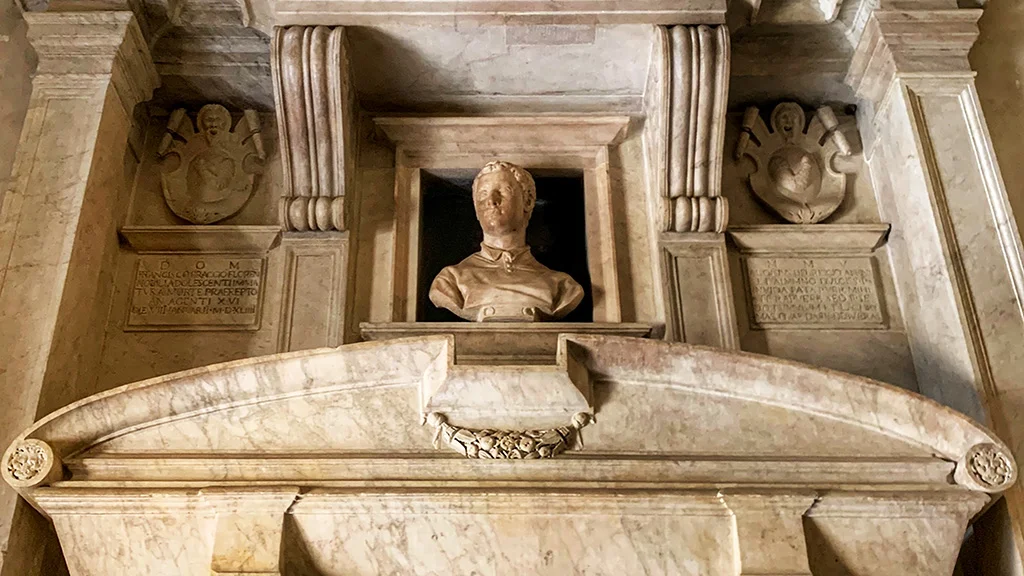 Although he did not carve the marble for the tomb himself, Michelangelo designed it for his grieving friend.
Although he did not carve the marble for the tomb himself, Michelangelo designed it for his grieving friend.Cecchino was the nephew of Michelangelo’s close friend Luigi del Riccio.
Michelangelo was deeply affected by the boy’s death and he designed the tomb as a personal gesture. (It was not built by Michelangelo, just designed by him.)
You'll find it near the side entrance of the church as you come up the back stairs.
It's definitely one of Michelangelo’s most private and lesser-known works in Rome, and the backstory makes me emotional whenever I see it.
A Pope's Body - Begun by Michelangelo but Finished by Another
In the Oratory of Santa Barbara al Celio (near the Forma Urbis museum), there's a statue of Saint Gregory the Great made by Nicolas Cordier in 1602.
The marble came from Michelangelo’s workshop.
The block was sold to Cordier by Michelangelo's nephew, and apparently, Michelangelo had already started working on this marble before abandoning whatever project it was.
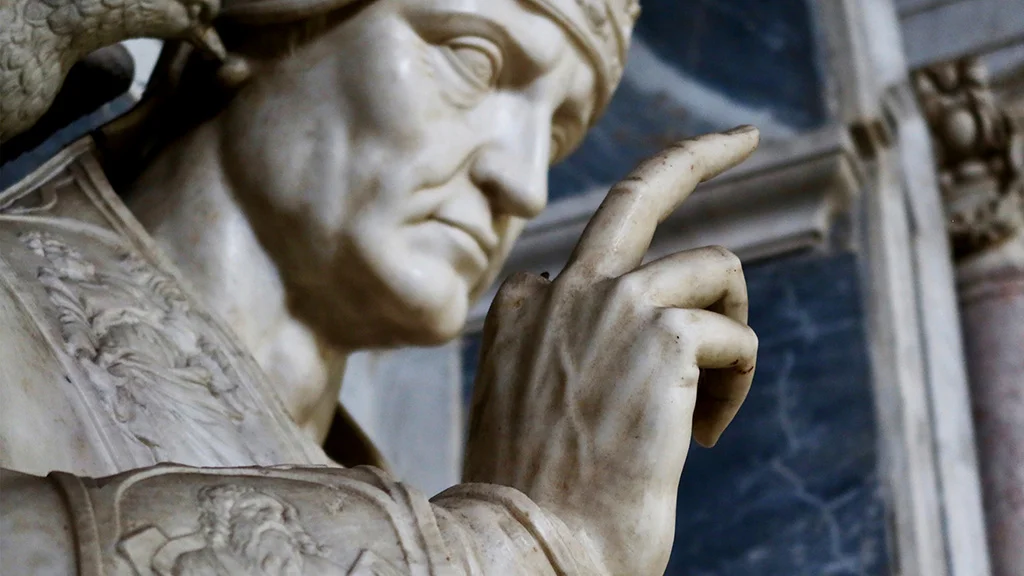 Michelangelo had begun working on this block of marble before Cordier finished it as a sculpture of Saint Gregory the Great.
Michelangelo had begun working on this block of marble before Cordier finished it as a sculpture of Saint Gregory the Great.My friend, renowned art historian Claudia Viggiani, an expert on Renaissance Art, has confirmed this block of marble shows signs of Michelangelo's work, notably, one of the hands where we can see veins, and the draped robes of the pope.
While the finished work may not have been by Michelangelo, knowing traces of his prior work were preserved is pretty cool.
These are not the last obscure places to see traces of Michelangelo in Rome.
There are more to discover. Keep reading...
Michelangelo's Architectural Work
Michelangelo started his architectural career in Florence under Pope Leo X.
It wasn't long before his talent was being recognized, with him being commissioned as an architect in Rome to work on piazzas, basilicas, and palaces.
Piazza del Campidoglio
Embarrassed by the thought of Emperor Charles V visiting the muddy Piazza del Campidoglio, Pope Paul III hired Michelangelo to redesign the rundown space.
It sits on top of the Capitoline Hill, one of Rome's Seven Hills, and has been at the heart of Roman life since the very beginning of Rome's history.
However by the 1500's it had become quite rundown and was not a particularly impressive place.
Michelangelo designed a trapezoid-shaped piazza to frame an ancient bronze equestrian statue of emperor Marcus Aurelius in the center, which he had studied in its original placement in the Piazza di San Giovanni.
While the statue in place today is a replica, the original was a relic of ancient Rome that had been misidentified as the first Christian emperor, Constantine.
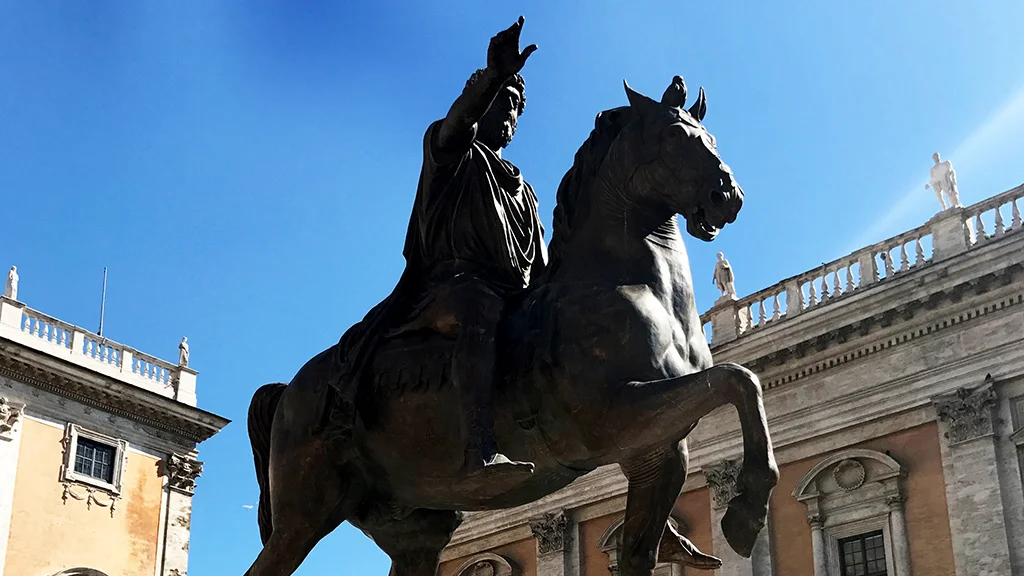 The piazza revolves around this bronze statue - now a copy of the original which was moved to the next door Capitoline Museums to preserve it
The piazza revolves around this bronze statue - now a copy of the original which was moved to the next door Capitoline Museums to preserve itThe design was intended to show strength and power through beauty, which is why it is still one of the most iconic places in Rome today.
Every detail was planned out carefully, moving the focused view of the hill from the Roman Forum to St Peter's Basilica.
The palaces were renovated and he added a third to create a sort of u-shape, as well as a new grand staircase, sculptures and more in his design.
The pavement is striking with its contrasting geometric pattern, which only was completed to the artist's specifications in 1940.
Michelangelo died before most of the piazza was completed, but his design was closely followed.
I always think that it's such a shame he never got to see his full vision realized, given how well the piazza turned out.
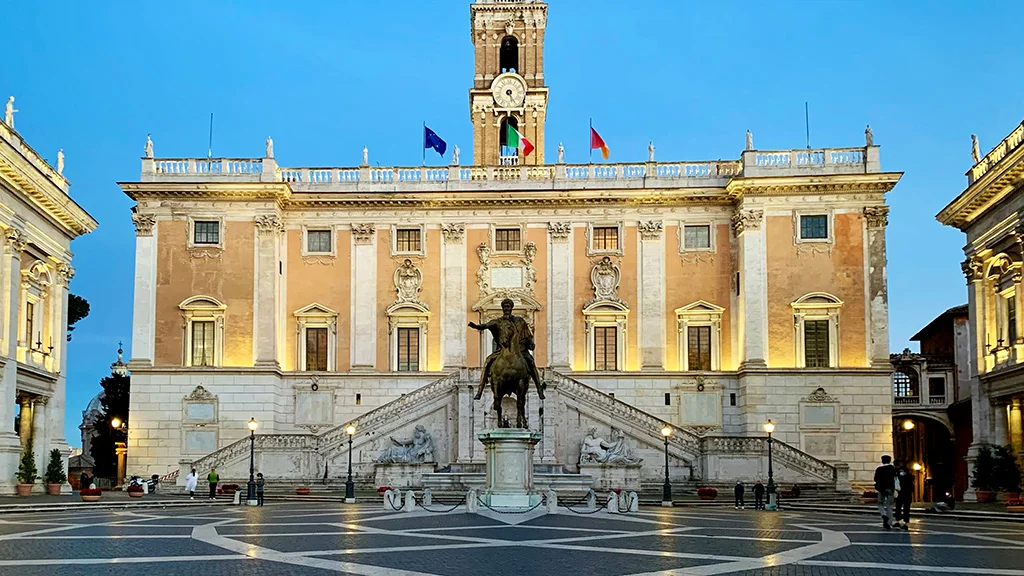 The palaces either side of the piazza are home to a wonderful museum that is one of my favorites in Rome.
The palaces either side of the piazza are home to a wonderful museum that is one of my favorites in Rome.Piazza del Campidoglio is flanked on either side by the Palazzo dei Conservatori and Palazzo Nuovo.
Michelangelo designed the latter to be completely symmetrical to the original palace.
Today, they house the Capitoline Museums, one of my favorite museums in Rome, so you can visit the museums and admire Michelangelo's work at the same time.
Basilica di Santa Maria degli Angeli e dei Martiri
Michelangelo designed the vaulted ceilings of the Basilica of Santa Maria of the Angels and Martyrs in 1559.
Its full name in Italian is the Basilica di Santa Maria degli Angeli e dei Martiri.
It was built on the site of the ancient Baths of Diocletian, large imperial baths whose ruins still stand today.
He incorporated the remaining walls of one part of the sprawling baths into the design of the basilica.
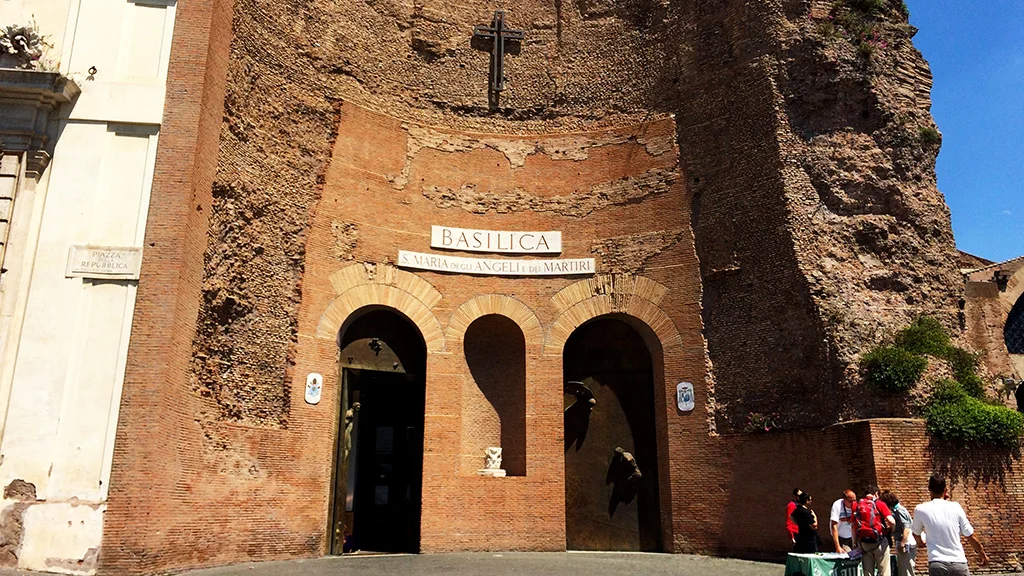 The ancient ruins were not entirely demolished - you can clearly see how the church building works within them.
The ancient ruins were not entirely demolished - you can clearly see how the church building works within them.The basilica is on one side of Piazza della Repubblica with a metro stop on the other side of the piazza.
Michelangelo also designed a cloister in another part of the ancient bath complex, which you can see when you visit the Diocletian Baths.
The baths are around the corner from the Basilica di Santa Maria degli Angeli.
They are part of the Rome National Museum system which means your ticket gets you into the other museums on the system over the course of a week.
Palazzo Farnese
Palazzo Farnese was one of the most important High Renaissance palaces in Rome.
It was commissioned by Alessandro Farnese (the future Pope Paul III), and was originally designed by Antonio da Sangallo the Younger.
When Sangallo died in 1546, Michelangelo took over the project.
He completely redesigned the courtyard and revised the third story by adding a deep cornice to the roof.
Another addition was the architrave (lintel), a papal balcony, as Pope Paul III received his title during its build.
Piazza Farnese is one piazza over from Campo di Fiori so is easy to see from the outside.
The piazza tends to be a lot quieter than Campo di Fiori, and you can also see two huge basins from the Baths of Caracalla which are now fountains - the recent restoration has made them look amazing.
The palazzo is now the French embassy so getting inside is more difficult, although there are guided tours which run at limited times that you can book.
Other Architectural Work by Michelangelo in Rome
Porta Pia was one of the last works Michelangelo completed before his death.
It was built between 1561 and 1564.
Famously, it's the last gate the Italian Army breached in 1870 to conquer Rome and make it part of the Kingdom of Italy.
Pope Pius IV commissioned the 'improvement' to one of the original Aurelian Gates and named it after himself.
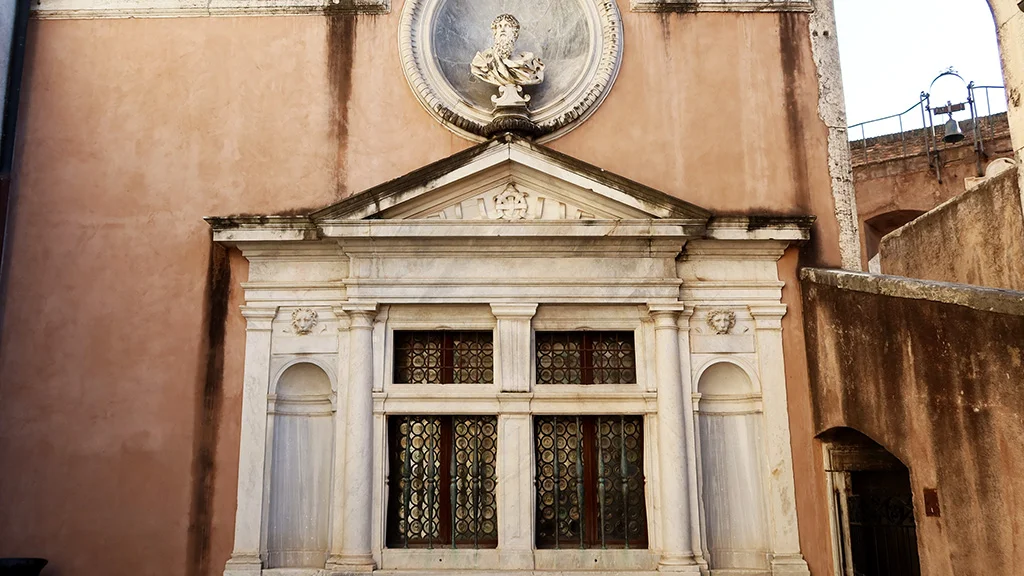 Most people who visit Castel Sant'Angelo have no idea this small shrine was designed by Michelangelo.
Most people who visit Castel Sant'Angelo have no idea this small shrine was designed by Michelangelo.Michelangelo was also one of two architects who worked on the Sforza Chapel in Basilica di Santa Maria Maggiore in the mid-1500's.
Sometime between 1513 and 1521, he also designed an aedicula (small shrine) in the Chapel of Leo X in Castel Sant'Angelo.
Michelangelo's Influence On Other Artists
Raphael and the Shadow of Michelangelo
Michelangelo’s art in Rome had a huge impact on the artists around him - none more famously than Raphael.
One of the best-known examples of this is in Raphael’s School of Athens, which you can see in the so-called "Raphael Rooms" of the Vatican Museums.
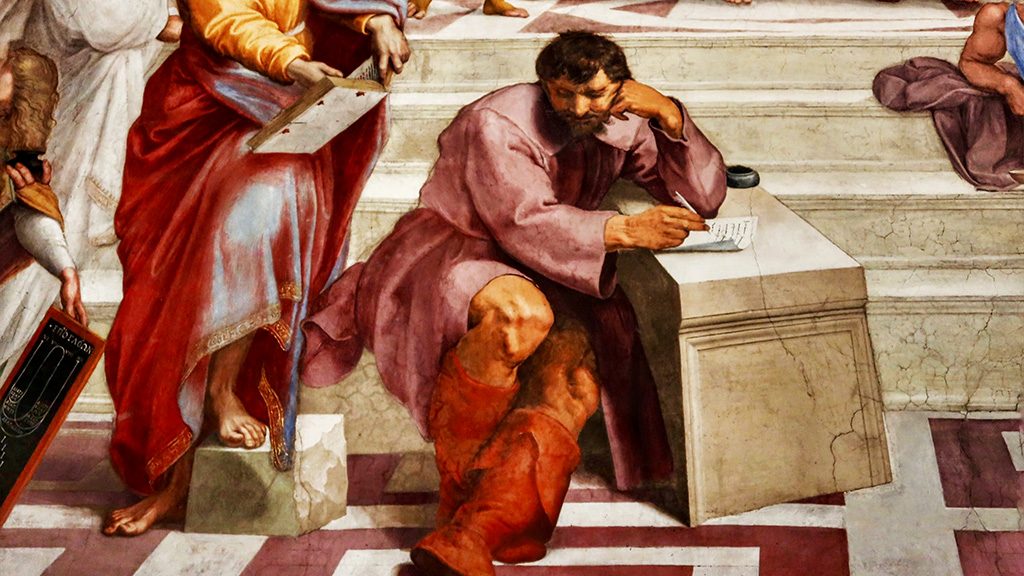 On the bottom left-hand-side of this fresco by Raphael, the School of Athens, you can see how he painted a figure who looks just like Michelangelo.
On the bottom left-hand-side of this fresco by Raphael, the School of Athens, you can see how he painted a figure who looks just like Michelangelo.In it, Raphael includes a solitary, brooding figure of Heraclitus who looks remarkably like Michelangelo and is wearing boots much like those of the great artist (and which don't match the Ancient Roman dress of the other figures in the painting).
Raphael added this figure later, after secretly viewing Michelangelo’s work on the Sistine Chapel ceiling.
No matter what season you visit Rome, here are 4 essential things we recommend never leaving home without:
Disclosure: If you make a purchase through a link on this page, I may receive a small commission - at no extra cost to you. Thank you for supporting my site!
A New Way of Seeing the Human Form
Michelangelo’s influence shows up again in Raphael’s painting of the prophet Isaiah in Sant’Agostino, where the twisting body and flowing robes are similar to the prophets on the Sistine ceiling.
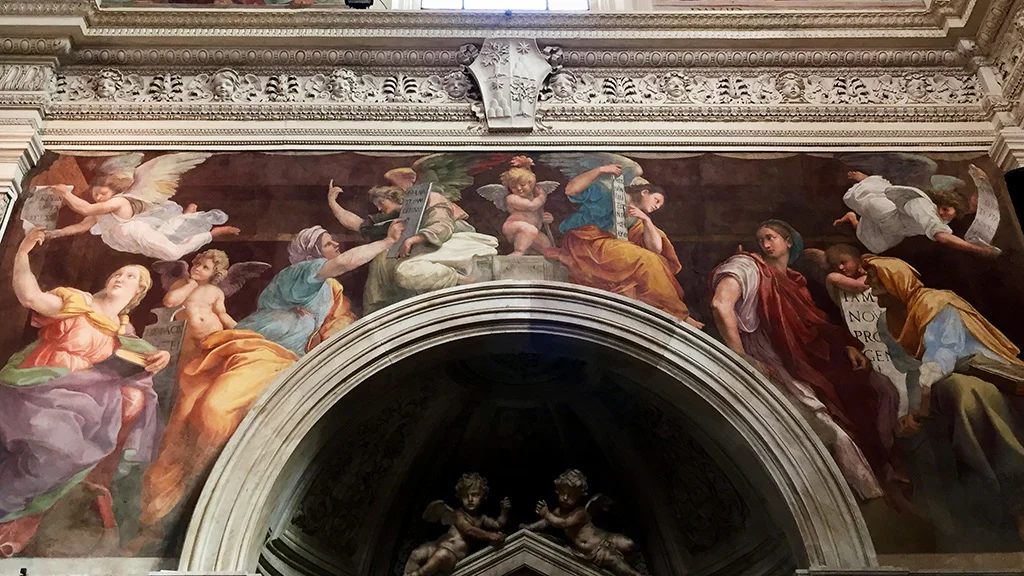 Raphael's sybils in Santa Maria della Pace in Rome look remarkably like Michelangelo's sybils on the Sistine ceiling.
Raphael's sybils in Santa Maria della Pace in Rome look remarkably like Michelangelo's sybils on the Sistine ceiling.You can also see his impact in Raphael’s Sibyls in Santa Maria della Pace, where the energy and musculature of the figures feel unmistakably Michelangelesque.
The Birth of Mannerism
Michelangelo’s dramatic, emotionally charged style helped shape a new art movement: Mannerism.
His late works, like The Last Judgment in the Sistine Chapel, moved away from classical harmony and introduced more tension, distortion, and complexity.
Mannerist painters like Jacopo Pontormo and Rosso Fiorentino exaggerated Michelangelo’s figures even further, embracing odd poses, vivid colors, and unusual compositions.
Legacy in Stone and Beyond
Michelangelo didn’t just transform painting and sculpture, he also reshaped architecture.
His design for the dome of St. Peter’s Basilica became one of the most copied architectural features in the world.
Long after his death, artists continued to look to him for inspiration.
The 19th-century French sculptor Auguste Rodin admired Michelangelo and said he was influenced by his art.
You can see this in Rodin's famous Thinker, clearly modelled after Michelangelo's Lorenzo de' Medici, Duke of Urbino in the Medici Chapel.
See the Vatican through Michelangelo’s eyes on a tour that brings his masterpieces to life! 🎨
Where to Find Traces of Michelangelo in Rome
Michelangelo spent a lot of his long life in Rome.
His best-known residences are the one in the now-lost neighborhood of Macel de’ Corvi, which is more or less where Trajan's Column is today, and (non-specified) residences near the Vatican.
This is where he lived on and off while working on large-scale projects there - notably the Sistine Chapel frescoes as well as on Saint Peter's Basilica's new design.
Michelangelo's First Stays in Rome
Michelangelo first came to Rome in 1496 as a young sculptor, where he quickly made a name for himself with his stunning Pietà.
But the real turning point came in 1505, when Pope Julius II summoned him back to Rome to design a massive tomb, an ambitious project that would consume (and haunt) Michelangelo for decades.
From that point on, Rome became his main base of work, even though he sometimes left in frustration or to take on projects elsewhere, like the Medici Chapel in Florence.
Still, he always came back, and by 1534, he moved to Rome for good.
Michelangelo's Modest Home in Rome
From 1513, Michelangelo lived on and off, and eventually permanently, in the old neighborhood of Macel de’ Corvi, near Capitoline Hill.
Though Michelangelo was wealthy and famous by then, he lived almost like a monk, with few possessions, and eating and bathing as minimally as possible.
As he told his friend and biographer Ascanio Condivi, "However rich I may have been, I have always lived like a poor man."
But he wasn’t isolated.
He kept a large studio filled with assistants and was deeply connected to friends like the noblewoman and poet Vittoria Colonna, with whom he shared a rich spiritual and emotional friendship.
What Happened to Michelangelo's Home in Rome?
The Macel de’ Corvi area no longer exists.
It was demolished in the late 1800's to make way for the enormous white marble monument to Victor Emmanuel II.
Today, a plaque on the nearby Palazzo delle Assicurazioni Generali di Venezia, overlooking Piazza Venezia, marks the spot where Michelangelo’s house once stood.
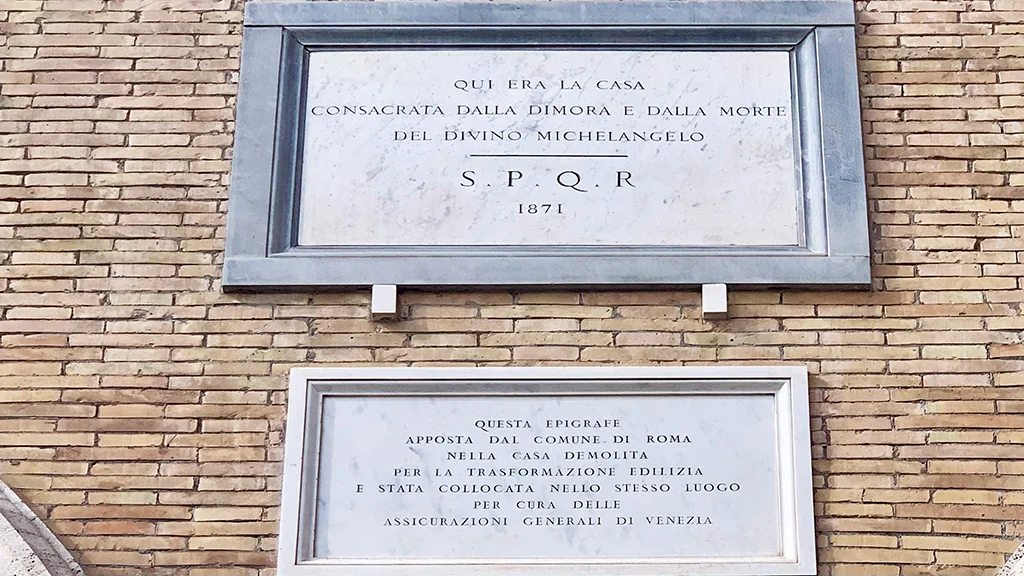 Near Piazza Venezia, you can find this plaque that commemorates the location where Michelangelo's home once stood.
Near Piazza Venezia, you can find this plaque that commemorates the location where Michelangelo's home once stood.The actual façade of the house was (said to have been) preserved and later relocated to the Gianicolo Hill, where it now stands alone, as part of a building behind it, but not really.
(NB - There is no proof this was the façade of Michelangelo's home, nor can we know it looked exactly like this if it was. But it might have been, and that's enough to make it interesting.)
What Happened to Michelangelo's Body When he Died in Rome?
When Michelangelo died in 1564, he was buried in the church of Santi Apostoli in Rome, but only temporarily.
The Medici family and his nephew Lionardo Buonarroti were determined to bring his body back to Florence, fulfilling the artist’s wishes.
In a bold move, they smuggled his remains out of the city under cover of darkness.
He was reburied with great ceremony in the Basilica of Santa Croce, where he rests to this day.
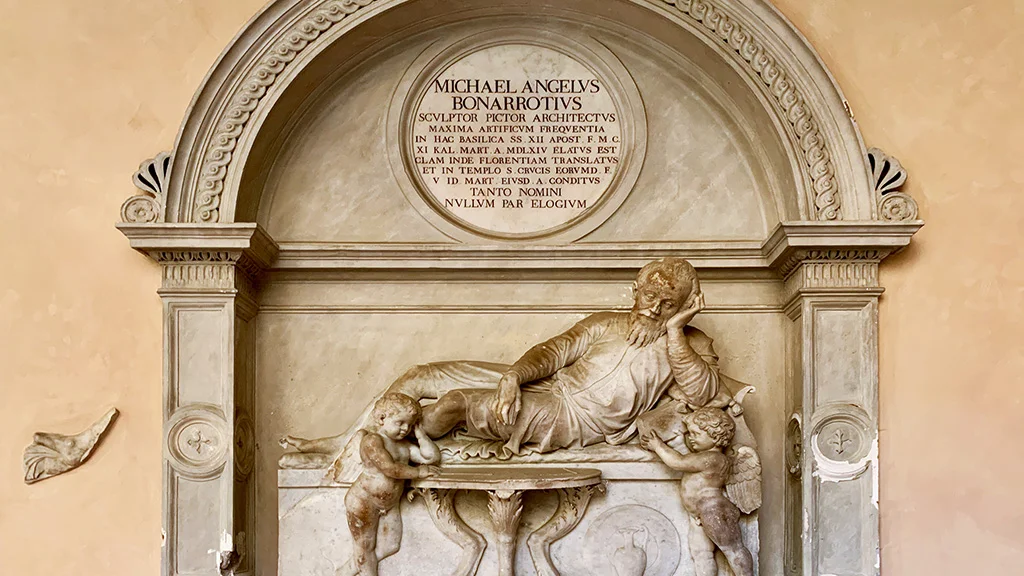 If you're lucky, you can visit the cloister where Michelangelo was briefly buried in Rome before being whisked away to Florence. NB - the figure shown resting is not a portrait of Michelangelo.
If you're lucky, you can visit the cloister where Michelangelo was briefly buried in Rome before being whisked away to Florence. NB - the figure shown resting is not a portrait of Michelangelo.That temporary tomb in Rome still survives, tucked away inside the cloister of Santi Apostoli.
If you visit, you might be able to see it - just ring the bell of the monastery, which is to the left of the entrance of the church as you face it and ask.
Sometimes, they will let visitors in for a quiet glimpse of this little-known part of Michelangelo’s story, I have been let in more times than not so ask politely and you'll hopefully be in luck.
⛲️ Discover Rome's most enchanting piazzas and fountains ⛲️
With an expert local guide, wander cobbled streets to stunning landmarks like Piazza Navona, the Spanish Steps, and the iconic Trevi Fountain. Step inside the magnificent Pantheon, a testament to ancient engineering, and soak in the unique ambiance of the Eternal City. Book now for the perfect introduction to Rome’s artistic wonders!
Other Places to See Michelangelo's Work in Italy
Michelangelo's art and architecture might be concentrated in Rome and Florence, but he left his mark all over Italy.
You can discover some of his famous works in Bologna, Venice, Siena, and Milan too.
Michelangelo in Florence
Michelangelo's 17 ft / 5.17 m tall statue of David is a must-see and one of the first pieces I ever saw of his.
Find it in the Accademia Gallery, along with four more of his pieces.
One of his earliest major works, Michelangelo crafted a Crucifix in 1493 from polychrome wood which is on display in the Santo Spirito church (art historians continue to debate as to whether it's really by Michelangelo though.)
The Uffizi Gallery is Florence's main art gallery, and there you'll find the Tondo Doni, an oil painting he created in 1503-1506.
You can also see several of his works in the Bargello Museum, the Museum of the Works of the Duomo, Casa Buonarroti, and the Medici Chapels.
Other Italian Locations
Michelangelo spent around a year in Bologna when he was nineteen.
He made three marble statuettes on The Ark of St Dominic in Basilica San Domenico in 1494-1495.
He also carved four marble statues of saints for Siena Cathedral in 1503-1504, although they're much bigger.
Check out St Peter, St Paul, St Gregory, and St Pius inside.
Head to Sforza Castle in Milan to see Rondanini Pietà, a sculpture he worked on during the last days of his life in 1564.
Romewise's Top Travel Resources
Ready to book your trip to Rome? Take a look at these helpful links to companies we use and trust:
- Keep your travel spending simple with the Wise card, which removes all the worry about exchange rates and high transaction fees all over the world
- Search for and book your perfect accommodation
- Our complete guide to what to pack for Rome
- The number one travel accessory, a multi-point travel adapter and voltage converter
- Browse a huge range of tours in Rome and beyond
- Experience unique tours and special access to Rome's most popular sights
- Protect yourself with comprehensive travel insurance
Within this post there are some affiliate links for products and services. For more details about our affiliate policy click here.
Get your 100% free Rome trip planner now!
Simply sign-up today for our free newsletter and get the Romewise Quick Start guide to Rome:
We are committed to respecting your data. Click for our Privacy Policy.
Comments? Questions? Suggestions?
Please come over to the private Romewise Facebook group and join in the conversation.
You will often find me there, happy to answer your questions / comments!
You will also meet other Rome lovers and experts, too.
What are you waiting for?
- Romewise Home Page
- What to Do in Rome
- michelangelo in rome

